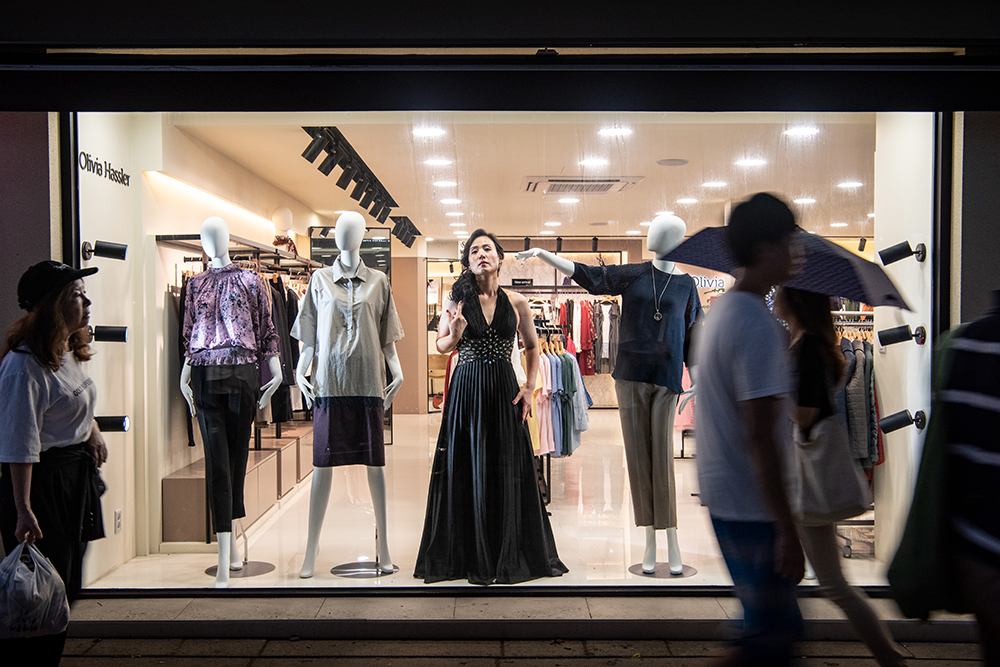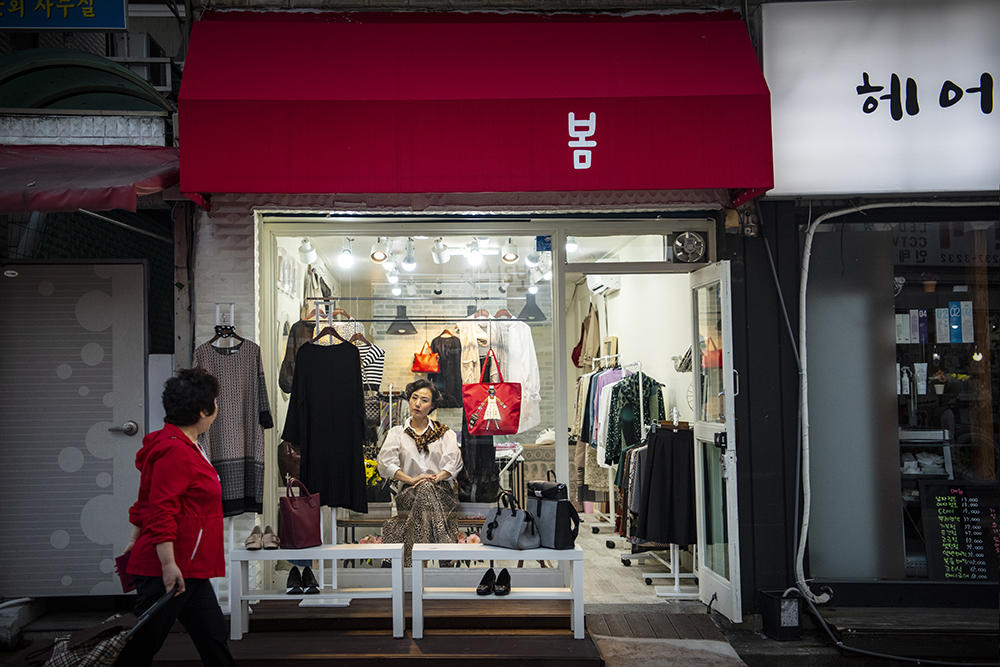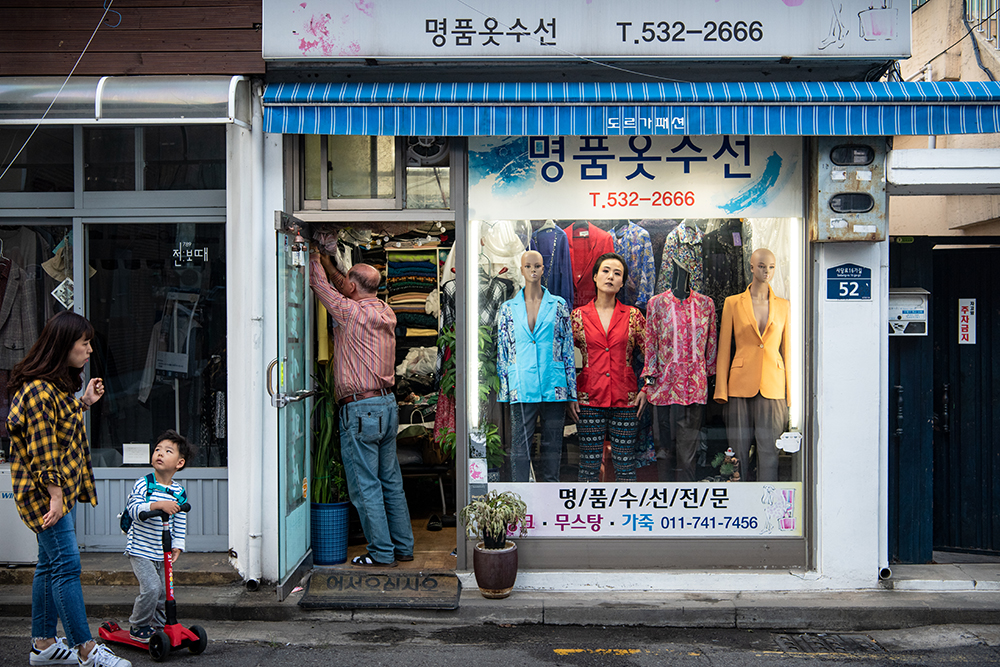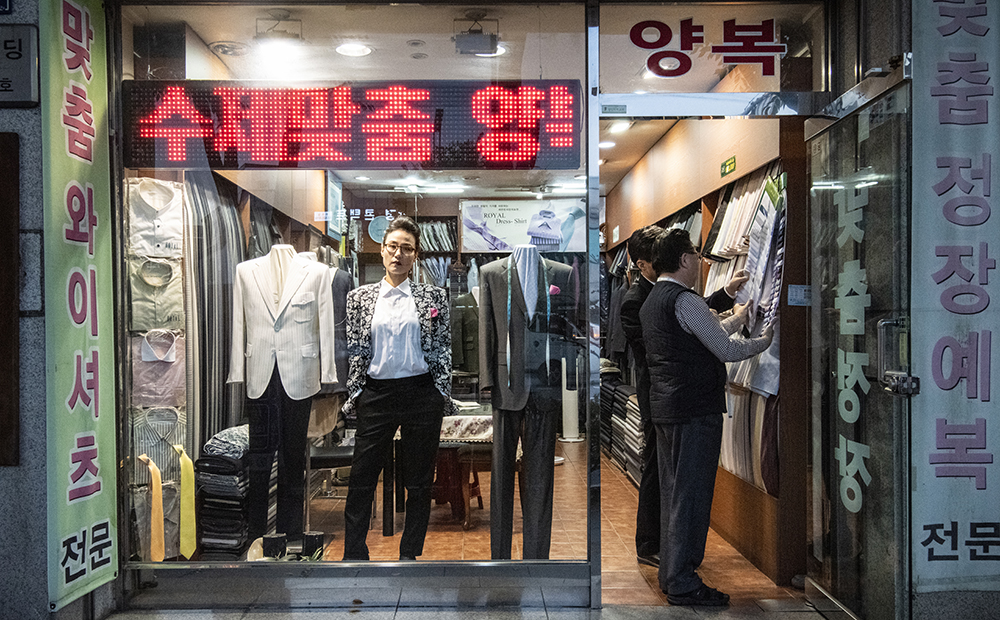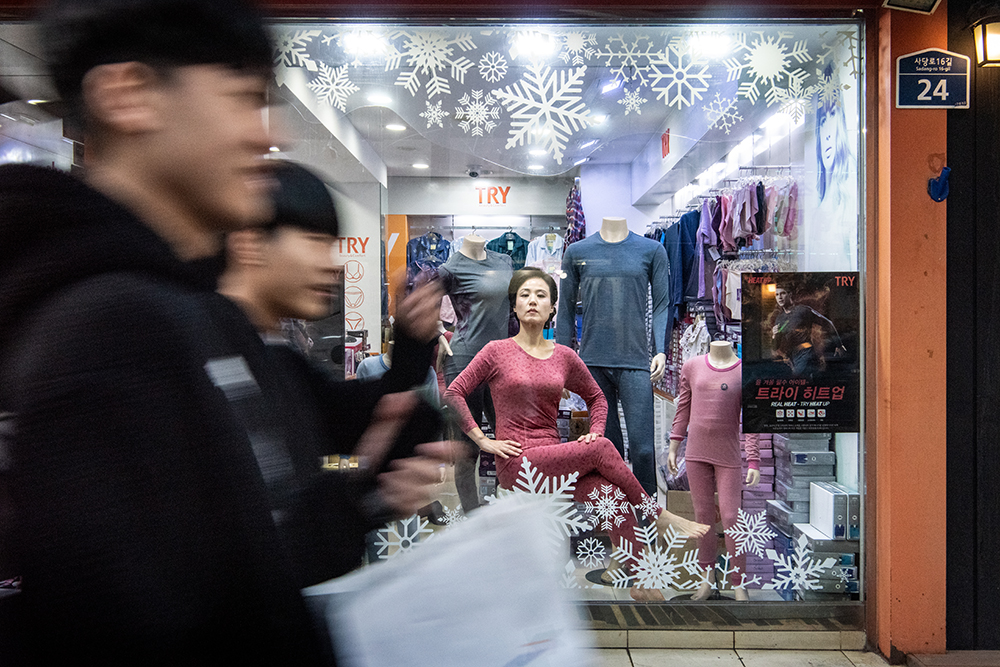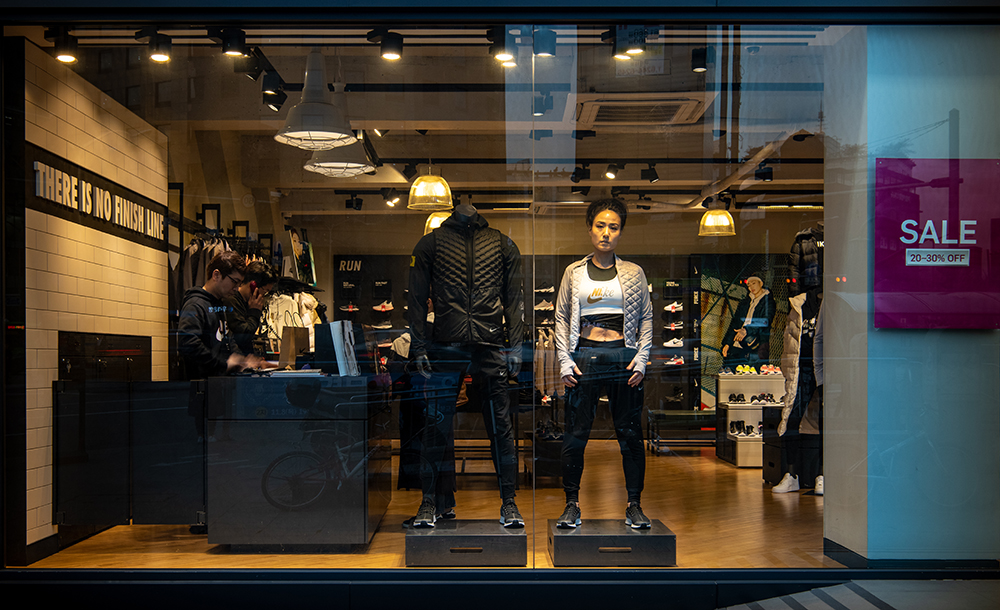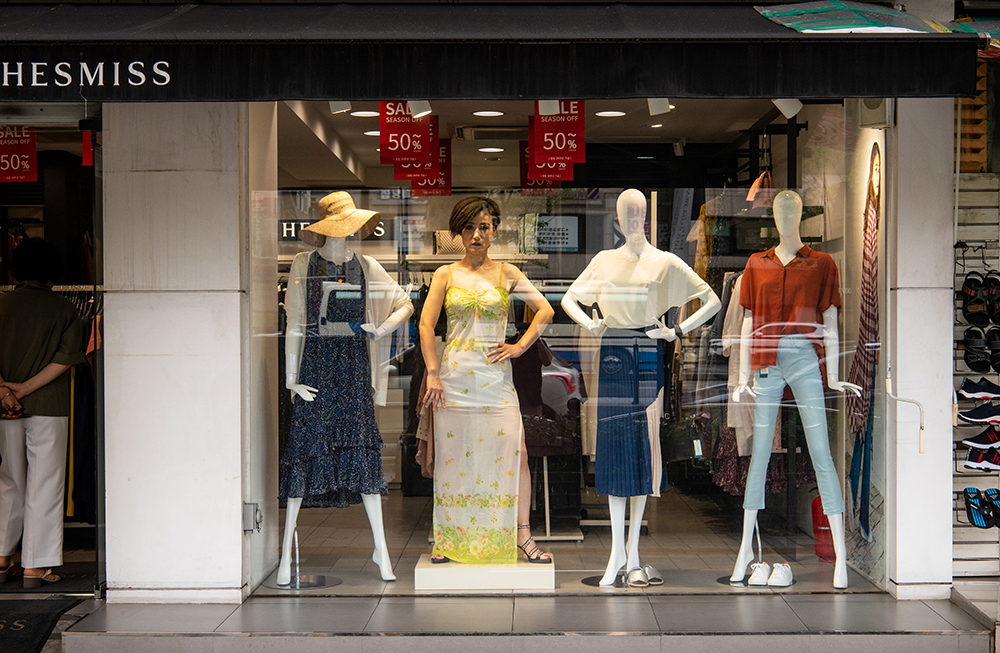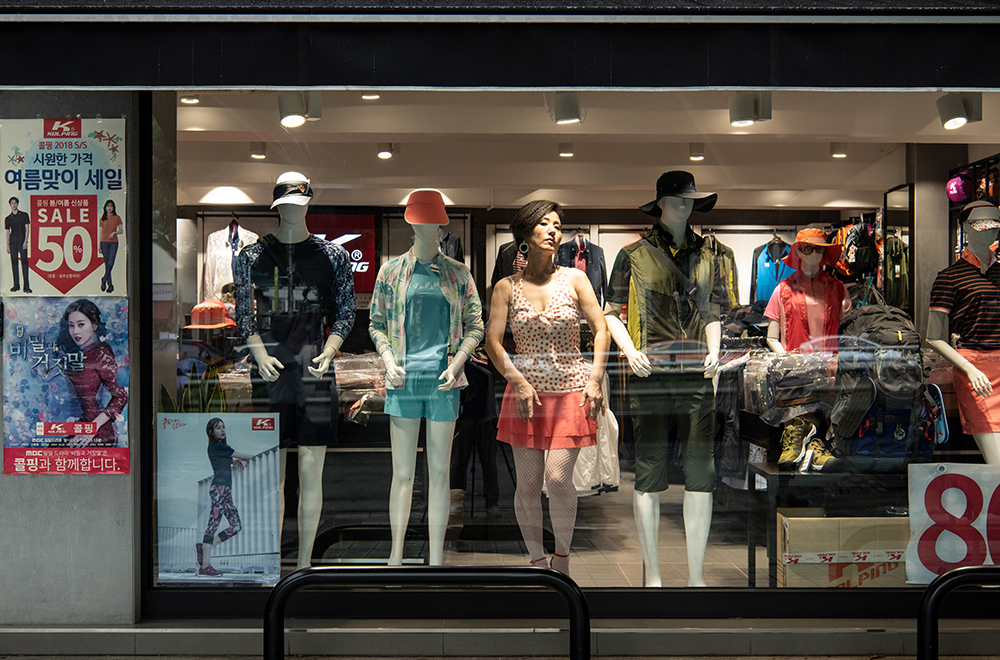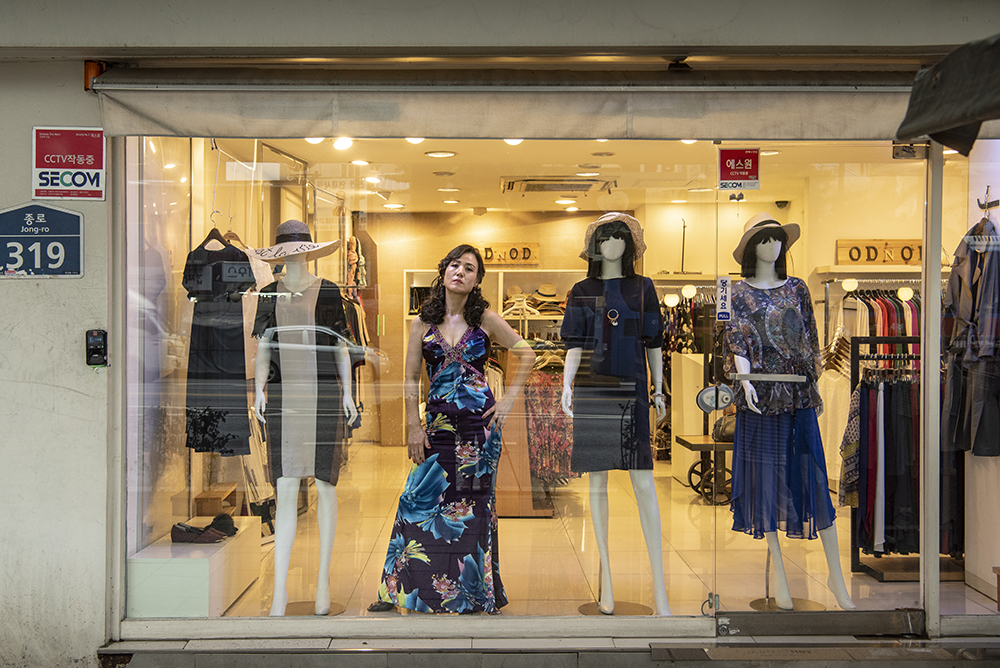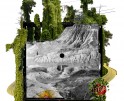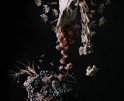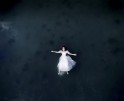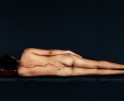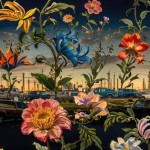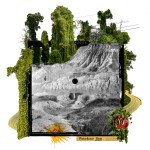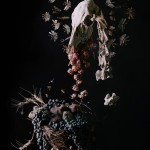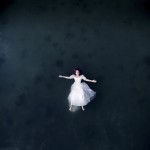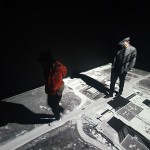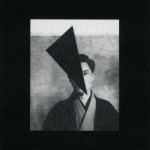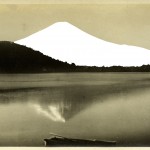South Korea Week: Woo, Young: Show Window
“The world reflected from the inside of a show window is more monotonous than it may seem. Reality and theater coexist on either side of the show window glass. Sometimes, reality feels like a scene from a play”. – From Woo, Young artist statement
One of my favorite activities as a child was dressing up dolls. Up until middle school, I spent most of my pocket money buying trendy clothes for my dolls. The dolls’ styles varied by types and scope of the garment such as the dresses and glass shoes found in princess fairy tale books to leather pants and bikinis. I engaged in doll dressing during my formidable years as a way to discover my ‘self’ as perceived between reality and the ideal.
“According to child psychologist Vygotsky, symbolic play expands children’s minds from concrete social reality to abstract thinking. Through ‘object substitution’ involved in symbolic play, children come to a more realistic understanding of their identities by way of decontextualized behavior.”
-from Symbolic play theories of Cognitive-Structural Aspects; Cho, Eun Jin
The work of Show Window by Woo, Young reminded me of the doll dressing activity from my childhood. The artist plays both roles of main character and director. The artist is both the doll and the subject who dresses the doll. Were the clothes on the doll in the Show window work, her ideal self portrayal?
It was then that I noticed her graduate thesis.
The artist is married to a pastor and the two of them have three children.
In traditional Korean societal norms (which exists even to this day), a woman’s role after marriage is determined largely by her husband’s societal position and influence. This is a way of life that sees women as subordinated to their husbands, as well as being primary caretakers of the family’s children. A woman’s life, in this traditional normative, is thus expected to fit into a male-dominated social structure.
With a first-person, lived experience in this oppressive social structure for years, Artist Woo, Young uses photography to depict a range of deep contemplations of her own identity, the suppressiveness of individual expression as a woman and the consequences of isolation from an abrupt interruption to her career.
Through Show Window, Woo is able to garner audience’s sympathy around the lost sense of female empowerment as she visualizes the painful societal norms around female identity, which was greatly undermined during a time when South Korea gained monumental economic growth after the Korean war.
Photographic Expressions of Personal Identity
using Makeup and Performance
– Focusing on Show Window –
“This thesis investigates theoretical background of Show Window produced in 2018 and analyzes artistic formation process of visual image with production motives and purposes, expression methods, and photographic media. Show Window began with questions about individual identity and its photographic work visualizing the process to find the answer. Human cannot help existing alone and exists in interactions with others while performing their roles in the society. The exploration for internal ego and external ego shows ego identity of inside and becomes recognition process for re-recovery of social organization including themselves and relationship with others. Social identity normalized by others restricts individuals, but becomes driving force to live as a member of positive society when performing roles subjectively.
This researcher was doubtful, ‘Isn’t it performance’, whenever experiencing the gap between internal ego and external ego, expected by others, in the society. Also, this phenomenon brought confusion of identity that seems to refuse my essential ego and replace with other ego. Due to the awareness of problem, self-portrait work began and internal awareness of this research was visualized as photographical work through Show Window.
The self-portrait work is shown to people who consider as reappearance by an objective form, but in here, workers’ own individuality and internal particular self-ego are included and expressed. The self-portrait is objective expression as well as achieves subjective intention the worker expresses the identity defined for him.
To support the work of Show Window, this researcher studied mirror theory of Lacan and standpoint of the sight of Sartre in relation to the individual identity and relations with others. Lacan insists that individual recognition of others is the structure human cannot help recognizing others originally, not is conducted by socialization process. Sartre insists that subjects cannot help recognizing others through sights and explains the relations with other existences with different awareness. In addition, this researcher analyzed and studied which relation the identity makes in the structure of social concept through theoretical socialization of Goffman. Goffman expresses the conflicts with role expectation of individuals and others as ‘discord of very humane ego and socialized ego’. In addition, by examining performance theory of Butler, this researcher analyzed the relations with Show Window. Butler says that all of identities are organized fictionally. It means that the norms idealized and internalized by the society are repeatedly performed and carved to the bodies.
For the workers embodying self-portrait, this researcher studied Cindy Sherman who is a representative worker about female identity. She expresses that famininity is organized by social and cultural code, not essential characteristics of women. Morimura Yasumasa progressed drama self-portrait work with makeup and performance. In addition, Claude Cahun shows flexible ego, not an appearance by others’ sight. Nikki Lee embodied photos in daily life through drama performance form and Gilbert and George developed the situation embodying arts in daily life through performance work.
For expression method, there are 3 characteristics of Show Window work. Show Window is firstly drama self-portrait with makeup and performance. For the work, show window shop was borrowed and photography was taken by taking a pose of mannequin. It intends to individual identity on the stage of daily lie as various performers. Second, it’s performance with theatricality. In the image, this researcher becomes mannequin and takes a pose of blank stare. His appearance who is standing with the pose becomes the image focused by others’ sight. Performance with theatricality can be related to my work as the identity cannot be fixed and can be changed to repeated performance. Third, simultaneity was expressed by including intended display by scenario and contingency occurred in the field on one scene. It can be the purpose to embody his awareness to expand arts to daily life through performance. In addition, it pursues to respect the process of work and expand the meaning of art’s social roles through embodiment of arts in daily life.
Through this study, this researcher discerned and analyzed accord and discord between internal ego and external ego, individuals are feeling while living, hoped that individuals can positively treat ego-splitting they feel in social organization, and suggested communicative possibility with internal ego academically. For ego identity as performer who is regulated by the society forcibly, it should be an opportunity to recognize internal experiences and emotions healthily by understanding and anticipating in relations with others. Internal ego and external ego are expanded by interactions and completed to one identity generally, not divided concepts.
Show Window began with awareness of problem about self-identity in this researcher’s individual experiences and inside, but intention to find my authentic appearance may be natural phenomenon applied to all of us. This researcher hopes Show Window that work and this study may be an opportunity of same introspection to all of individuals who are living with others in social organization.” -Abstract of Woo, Young’s Master Thesis
Woo, Young b. 1970
While Young Woo majored in photography in college, she had a hiatus in her career as she gave birth to her children and had to take on a major responsibility as the pastor’s wife.
Wooyoung received her bachelor’s degree at Sangmyung University in 1993 and master’s degree at the Graduate School of Hankyong University in 2020 – both degrees were in photography. Currently, she is pursuing another master’s degree in a divinity program at Torch Trinity Theological Seminary. She is interested in understanding human groups and exploring the existence of individuals in groups. She plans to expand her portrait work in various topical avenues such as spirituality and selfhood in the future.
Follow Woo Young on Instagram: @wooyoung_35
Sunjoo Lee: Given the wide-range of specialty areas in photography — such as fine arts, advertising and press — which branch of photography were you interested in exploring in college? And as a result, what kinds of projects were you involved in?
W00, Young: I got interested in videography while taking a multivision/media course in college. As a result, my graduation exhibition was exhibited in a digital slideshow format. I graduated college in the early 90s when analog was widespread. I used slide films and made videos by connecting 2 to 6 projectors. I remember creating a video slideshow project by inserting music and narration. At the time, the blending of sensorial elements such as audio was a rare form of photography presentation. After graduating from college, I got a job at a videography company. One part of my job consisted of creating assets and taking photos for expositions. I also worked as a freelancer and tutored students.
SL: After college, you were active in the professional photography industry. However, you experienced isolation after marriage and having to forgo your career. I’d love to know more about your decision to quit your job and what your life was like during your career break.
WY: I got married to a pastor, and in Korea, pastor’s wives have a special title. The role of a pastor’s wife is significant and differentiated in our society. I was placed into a unique position given my husband’s career path and given the circumstances, I was under a societally-constructed identity. My inability to construct a self-identity was exacerbated through the fact that I needed to be a strong mother figure to my three children. During this time, I experienced major internal conflicts, as I had to juggle the societal expectations of being the pastor’s wife and mother of three children, while having to come to terms with losing my professional career. As I left for missionary work in Ethiopia, life in Africa and the mission field was directly related to the dire supported need for human survival. I had no choice but to devote myself to missionary work with my husband only by the power of faith. As a Christian, I believe in God’s answer to open the way when the timing is right. My life in Ethiopia had no room for anything other than missionary work and raising young children.
SL: In order to understand the concept of identity portrayed in your work, I’d love to know more about your personal background, such as your childhood, your family and living environment growing up.
WY: I was the youngest among three siblings in my family. My mother was a woman with a strong passion for education. She sent me to church since I was 5 years old. My mother also had a job as a teacher, but gave up her work to raise her children. However, my mother ended up running a small clothing store next to our house for financial support. As a child, I spent a lot of time in her store and particularly, her store-front, show window became my playground. I grew up watching my mother change the clothing on the mannequins and create new outfits. Such an environment influenced the formation of my identity. I’d say my childhood memories of that space largely influenced my Show Window work.
My mother is a devout Christian. Her Christian thinking greatly influenced my identity formation and photography work. Ironically, my mother felt uncomfortable with my major in photography. Photography is a worldly thing, and my mother did not respect me as a photographer. My artistic desires were suppressed under the influence of my mother, who valued a religious life. My desire to do art exploded, and the expression of that desire was revealed through my work.
SL: It must have been difficult in many ways to be the pastor’s wife in the Korean social structure. What was life like before you came back as a photographer?
WL: As a pastor’s wife, I did my best to go all-in on evangelism for the revival of the church. I devoted 10 years of life to the growth of the church led by my husband. I put all my passion and energy into evangelism. I’d like to believe that some of my efforts contributed to the revival of a larger church. But who had I become as I completely lost grip in forming my own identity? This made me question my existence and identity.
It was at this time of reckoning that I found photography again. With the advice of a university teacher, I went to graduate school for photography. During those three years, I confronted my worries and questions around identity through photography. The inevitable career break due to marriage made me realize how isolated I was from other parts of society and myself. Beyond the fact that I was living a life as a pastor’s wife, the heavily-entrenched conservative, patriarchal and Confucian way of life in Korean society had made it difficult for me to discover myself independently.
After years of being married and having put in little work into my own livelihood, the beginning of grad school years was when I began to unravel the unfamiliar appearance of myself and the gap between me and society through the photographic language.
SL: The Show Window series started from the awareness of issues surrounding subjective viewpoints around self-identity. In that regard, I’m curious to hear more about the meaning behind your conceptual work.
WY: Yes, the Show Window series started with the question of ‘Who am I?’. I was confused by the social position of being the pastor’s wife and the restraint I had to practice given the norms of faith versus the desire to express myself as a human being. Through Show Window, I aimed to overcome the uncomfortable relationship between my proclivity to be an artist and my role as a wife. Through my experiences, I had learnt that faith and art had to be separate, a dichotomy exerted by social demands. Those two areas were perceived as being antagonistic to each other in the eyes of our society. In my work, I try to break the social norm that separates faith and art and to harmonize those two ways of life with my photography work. The Show Window is intended to reconcile and integrate faith and art through the understanding of the essence and the non-essence. For me, I came to understand the essence of being a human being with artistic talent under the conviction that I am a child of God.
SL: What is the symbolic meaning of the work, Show Window?
WY: A show window is a literal space where other people’s eyes gather. The exposed glass allows for people’s consumption of decorative displays. Symbolically, the show window stimulates human desire and is a space where you can project an idea yourself while looking at the mannequin.
A French thinker Jean Baudrillard (1929-2007) once said,“The show window is neither ‘inside nor outside’ of the store, nor is it a private or public space. Products are packaged and staged to be seen by others through the glass window, and the communication that takes place at this time is not between objects and individuals, but between individuals. This means that an individual not only looks at the product while looking at the show window, but also reads the social sign system and the hierarchical code of values.”
Thus, I think the show window space is the culture to which I belong. We exist in the culture and society to which we belong, and our roles within it can be seen as shaping our individual identity. So I set a space called the Show Window as the central background of my work.
SL: The series is a self portrait work where you play the role of a mannequin in the show window. What is the meaning of the mannequin?
WY: I think back to the deconstructed mannequin with detached arms and legs in my mother’s store when I was a child. My mother would always disassemble the mannequins to put on new outfits in the store window. As a child who always played in the window of my mother’s store, the mannequin was a soulless portrait, an object that caused fear and terror. A mannequin is a human figure, but has no soul. Freud said that the uncanny emotion is a variant of the fear that has long been known.The mannequin, a figure of a soulless person, represents the fantasy of capitalism that attracts people’s attention and stimulates consumption.
SL: You wrote a thesis on identity. What is identity? Could you give a brief description of your conceptualization of identity that changes according to
WY: Yes, let me briefly explain the background of my thesis. The identity I refer to in my research is closer to the concept of self. Identity that I explore is more closely aligned with self-identity or self-understanding. Many theorists examine identity through the social, i.e., connection with others. As humans grow, they realize that they exist as individuals when they are with others. It can be seen that the recognition of an individual’s identity is also established on the premise of one’s relationship with others in society. An individual’s self-identity is related to the social identity that is formed in the social environment and relationships with others. I build on this perspective of identity and state that individual identity is formed by the complex action of self-recognition within oneself and the recognition from others.
SL: I feel that there is a theatrical element in your self portraits. You seem to be doing a kind of a performance. What do you think is the most important part of directing and staging?
WY: I believe that an individual’s self-identity is formed in the interaction between being pressured to conform to a group or society’s cultural norms. In this regard, I tried to put on a theatrical performance in the form of a play and to portray the action of acting in each image. Using the show window as the stage, we staged a main character and tried to maximize the theatrical effect by using makeup, hairstyles and costumes. Like a mannequin, I kept a fixed gaze and face and maintained a full body pose with a firm posture.
My theatrical pose is supposed to depict my consciousness of other’s gaze on me and is intended to show an artificial appearance. I also kept a consistent deadpan to draw the viewer’s attention. I was able to discover another side of myself through this self portrait work. It was a process of finding my inner essential self while acting as a different person.
SL: You said that Show Window started out from an interrogation of issues surrounding the oppressiveness of women’s identity in Korean society. Did you find a conclusion about identity through your work? And lastly, could you give me a window into your plans for the future?
WY: Yes, it was with the series Show Window that I found a breakthrough from the very confusing feeling of ‘Who am I and what am I living for’ due to the restrictions that came from my long career break and my social position as the pastor’s wife in Korea. The memory of the mannequin in the window of my mother’s clothing store and that space being my childhood playground became an important motif for this work. It has been an opportunity to reflect on my past and to connect my previous experiences to my present self.
The performance of dressing up as mannequins in various stores and staging plays has allowed me to openly express my artistic desires without societal pressures. As a woman in Korean society, I have always been conscious of others’ judgments of myself. This work was an opportunity to contemplate my life that was oppressed by social norms into a life in which I became the subject. Through photography, I found harmony with a side of myself that was uncomfortable and unknown and found liberation in the discovery of those aspects. As a believer, I am confident that I am a child of God and I want to continue my independent life through my artistic talent. In terms of future work, I am planning to use clothing as a major theme to draw on my mother’s memory.
“Whether the current situation is real or unreal,
Whether it’s a scene from a play or a show window,
dreams and reality become one when you try to control your imperfect emotions.
The theater and reality coexist with a glass wall in the show window.
I want to show the gap between my essential self and my role in society through photography.
I want to visually express my relationship with others.
When the ideal values pursued by a group are accepted as norms to be followed, I become anxious about my identity slipping away.
The show window image helps interrogate those feelings to expose our consciousness around the gaze of others.”
-from artist statement
Sunjoo Lee is a mixed media photographer based in Seoul, South Korea.
Lee’s extraordinary artistic sensibility that was once portrayed through her voice is now visible through the works portrayed through her camera lens. Her photography focuses on a unique lyrical journey into her personal life. She explores her past, present, and future world in a temporal and spatial perspective.
She received a BA in Music from Ewha Women University, a second BA in Photography from Chung-Ang University(Academy credit bank system), and an MFA in Plastic Art & Photography from Chung-Ang University Graduate School of Photography in Seoul, Korea. In 2019, she was awarded into the 11th cohort for the prestigious artist residency program at the Youngeun Museum of Contemporary Art. Through this residency, she’s currently working on her upcoming series.
Lee’s acclaimed works have been exhibited widely throughout the years in South Korea. Most recently, she had her solo exhibition at the Youngeun Museum of Contemporary art, Gwangju Korea. She’s also showcased at Gallery Now, Gallery Gong, Gallery Guha, and more in Seoul, South Korea. Her works are permanently displayed at the Haslla Arts Museum (Gangneung, Korea), and YoungWol Y. Park (Youngwol, Korea).
Her work at large, incorporates everyday objects and subjects to make visual sense of the complexities of human emotions and feelings derived from the intangible, such as music. Her photographic inspiration stems from her experiences of living and travelling abroad. She extracts the memories and various emotions born out of the human connections she’s made during that time of being in foreign spaces.
Building on this conceptual narrative, her work has landed her multiple recognitions, from the 2019 Critical Mass as a top 200 Finalist (USA) to the 1st Place Richards’ Family Trust Award during the 25th juried show at the Griffin Museum of Photography (Winchester, USA). In Korea, she was received the Dong Gang International Photo Festival’s Now and New Exhibition award.
Follow Sunjoo Lee on Instagram: @sunjooleephotography
Thank you to Sejin Paik for her excellent translation
Posts on Lenscratch may not be reproduced without the permission of the Lenscratch staff and the photographer.
Recommended
-
Earth Week: Aaron Huey: Wallpaper for the End of the WorldApril 26th, 2024
-
Earth Week: Casey Lance Brown: KudzillaApril 25th, 2024
-
Tara Sellios: Ask Now the BeastsApril 6th, 2024
-
ALEXIS MARTINO: The Collapsing Panorama April 4th, 2024
-
Emilio Rojas: On Gloria Anzaldúa’s Borderlands: The New MestizaMarch 30th, 2024

